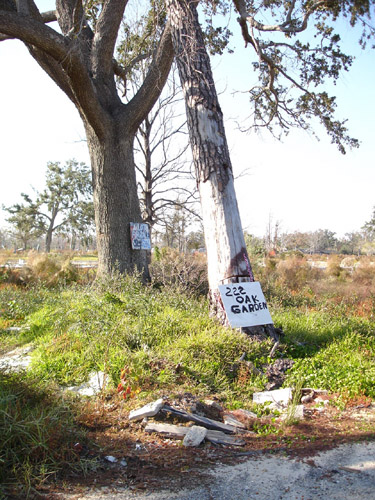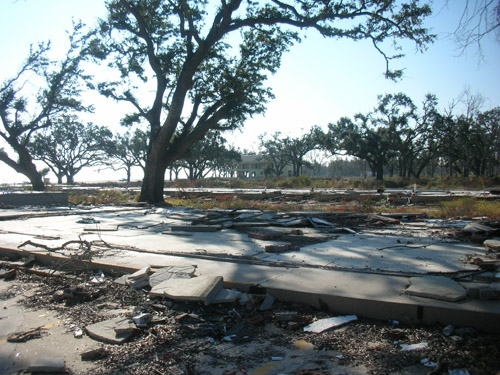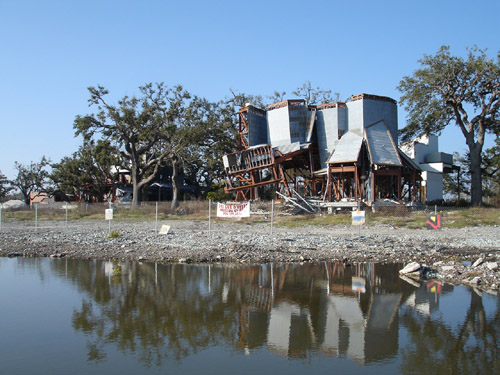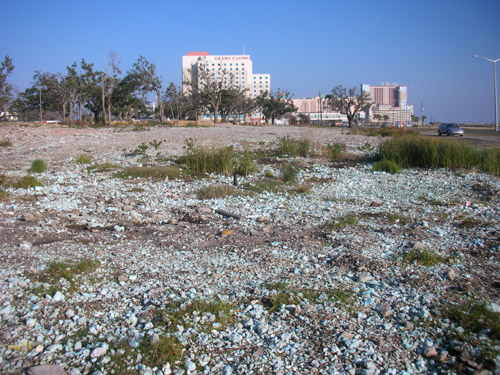Biloxi Blues
Katrina's destruction of the Mississippi coast left many residents homeless, unemployed, and vowing recovery. One year later, our writer revisits the coast, but finds little sign of progress.

Things at Sea Oak Estates haven’t changed much over the last year. Located a few miles west of downtown Gulfport, Miss., right on the water, Sea Oak is little more than a field of poured-concrete foundations and the occasional swimming pool, many of which are filled with brackish water and junk, barricaded by chicken wire. Though the local government has gotten around to replacing the street signs, little else, it appeared, had been restored. In the immediate aftermath of Katrina, it seemed impossible that the area along the Mississippi Coast could look much bleaker. And yet it does.
A few days after the storm hit, The New Republic sent a colleague and me to Mississippi and Louisiana to survey the damage. The difference between the two regions was striking. The Mississippi coast had been hit by a storm surge that tossed hundred-ton barges into parking lots and pushed almost everything along the beach—houses, cars, trees—into a mountainous pile of garbage 300 yards back. But then the waters receded, the emergency crews came in, and the rebuilding plans began to hatch immediately. I attended a church service the Sunday after the storm where I heard as much optimism as sadness, as much “we shall overcome” as “what hath God wrought?”
New Orleans was different. The levees broke and sent millions of gallons of water churning into the city’s low-lying areas, and it stayed there. A week after the storm had passed, the scene along Canal Street and the Convention Center, in the Ninth Ward, and Plaquemines Parish were still redolent of hell—human misery baking in the hot September sun, with no talk of rebuilding, no optimism, no hope that things could ever recover.
In the year since, the media’s Katrina coverage has, understandably, been on New Orleans’s slow pace of recovery, the continued corruption and inefficiency of the local government, and the criminal negligence of the federal government—the assumption, or at least the implication, being that Mississippi was, in contrast, doing just fine. That was my assumption too, one reinforced by anecdotes and local opinion. The Mississippi Renewal Forum promised in August that “progress is measurable.” At an Iron Bowl party in Mobile, I had heard that, unlike corrupt and lazy New Orleans, the Mississippi coast was coming back fast.
So what does progress look like? A few weeks ago I returned to Biloxi and Gulfport and found out. The mountain of storm debris is gone. Sea Oak and its neighbors have been picked clean of salvageable items, leaving only the errant china plate or ripped T-shirt. The Copa, a floating gambling palace once parked off the Gulfport docks but pushed by the storm surge into a massive parking lot, has been moved away. The sailboat that had landed leeward of a Best Western in downtown Gulfport was gone. A few brave developers have put up new condos, and several casinos are back in action. Strangely, most of the dozen or so Waffle Houses in the area are once again serving breakfast.

But the bright spots turn out to be few and far between. The Ohr-O’Keefe Museum, a Frank Gehry-designed scrum of galleries in Biloxi, is still a hulking skeleton. Drugstore signs still front empty parking lots, the buildings behind them having vanished in the storm. The Best Western, surrounded by a high fence, has the pregnant air of a structure already condemned to demolition, but granted a temporary reprieve because its owners can’t afford to carry out its sentence.
And there is no one around. When I was here in September 2005, the area hummed with activity. Now isolated work crews hum around only a few buildings. A church congregation sits outside a house, with folding chairs for pews—a banner reading “Christ Returned, and So Shall We” above the makeshift altar. But there are few cars on the road, no one walking the sand-stripped beach.

Nor does hope lie in statistics: More than 97,000 Mississippians still live in FEMA trailers. Unemployment in the Biloxi-Gulfport region is down from 21.1 percent in October 2005 to 8.1 percent a year later, but that’s because most of the unemployed have left. Indeed, the labor force has shrunk by 15,190 over the year, not so much for a lack of jobs as the lack of houses and infrastructure to support living near them.
Granted, this may be the reality of reconstruction. Despite expert predictions of a long road to recovery, I had underestimated what recovery would take. I expected last September’s gritty optimism to translate immediately into visible progress. I expected the homes of Sea Oak Estates to be, if not returned to their former health, then at least wrapped in Tyvek casts.
But what to make of the fact that the biggest improvements have occurred in the coast’s profit centers—casinos, golf courses, and resorts? It is no surprise that in a state as conservative as Mississippi, the “plan,” for what it is, hinges on the market’s ability to generate growth, namely tourism. Indeed, the gambling industry plans to come back better than before, with 20 casinos by 2010—as opposed to just 12 before Katrina. And this will, indeed, generate jobs, which will generate demand for housing, which will generate, finally, recovery.

Or will it? Many casino workers now commute from far inland, where they have resettled; the idea that developers will rush to build them new low-cost housing closer to their jobs is a free-marketeer’s fantasy. And casino work is hardly lucrative—other than dealers, it involves mainly dead-end service jobs.
What is ultimately cause for despair along the coast, however, is not that it is taking longer than expected to recover, but that it is already clear that its recovery will be aimed toward the status quo ante. Underlying the optimism of 2005 was not just “we shall overcome,” but “we will return better.” A more equitable, diverse economy, more responsive government, better-designed communities. Standing on a concrete foundation in Sea Oak Estates, gazing at the high-rise casinos glittering to the east, one fears those things are not part of the plan, after all.
